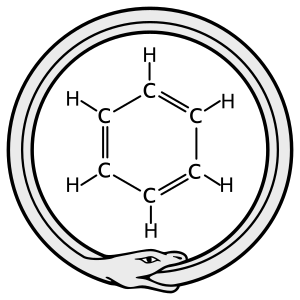The myth is that Isaac Newton had an ah-ha moment when he watched an apple fall to earth and thought that it must be the same force between apple and the planet earth that made the apple fall and that between the sun and the planets that made the planets revolve around the sun.
 |
| The ouroboros, Kekulė's inspiration for the structure of benzene. |
Kekulé spoke of the creation of the theory. He said that he had discovered the ring shape of the benzene molecule after having a reverie or day-dream of a snake seizing its own tail (this is an ancient symbol known as the ouroboros).[10] This vision, he said, came to him after years of studying the nature of carbon-carbon bonds.I have had a few, much less important ah-ha! moments of my own.
Years ago my colleagues and I were trying to develop an automatic pattern recognition system. We were using digital images of human classified pictures, and were stuck at about 90% accuracy. My ah-ha! moment came when I wondered if the people doing the classification were always right. Turned out that they agreed with each other about 90% of the time.
Another time I was in a graduate seminar and a fellow member presented his computer routine for solving the maximum flow in a network. He had tried to prove that it was an algorithm -- that it always got the right answer -- without success. It occurred to me that his routine always searched for the shortest path from start to finish in the network that was not already carrying its maximum flow, and maximized that flow. However, he had not used that fact attempting to prove the routine was algorithmic. I did, and presented the result to the seminar. The original author of the routine, now convinced he was right, produced and published an elegant proof.
A third time a friend and colleague showed me a computer routine he had developed to predict the performance of a reverse osmosis membrane. Ah-ha! I knew about Newton's method for optimization of a function, and told my friend that he could use his computer model and Newton's method to optimize the performance of a reverse osmosis system against the independent variables he used for his model. He was nice enough to credit me as coauthor of five publications he wrote using the method.
I don't have a mind's eye; I think in words, and am strong on logical inference. Those are the mental tools that resulted in my ah-ha! moments. Kekulé almost surely was using his mind's eye to visualize the snake becoming an oureboros. Who knows how Newton's mind worked -- he was such a genius. In my post yesterday I wrote about different ways that mental representations can be formed, assuming that different ones are available to different people. It may be important to develop the ability to use a mental representation matched to the kind of thinking one wishes to do. Thus, a chef might work to perfect her mental taster, while a playwright or author might focus on her mind's ear.
The ah-ha! moments people experience come from thinking. Sometimes that thinking is done consciously, and sometimes the conscious thinking is done using the mind's eye or other mental representations tied to sensory data (and benefited by memory of sense data received in the past. Sometimes the ah-ha! moment comes from unconscious thinking. I well remember walking around for days at work with the feeling that I was on the right track to understanding something -- a sense that arose no doubt from thinking of which I was not conscious. Sometimes it comes from specific thought experiments.
I was fortunate enough at one point in school to take a course in analog computers. Today I suppose they are seldom if ever used, and instead we simply use computer packages to simulate the equations describing the system we want to simulate on a digital computer. In the old days, however, people used physical analogs that had been manipulated so that their functions could be described by the same equations that describe a real physical system of interest. Still today, people build and use simulation models to better understand real systems. Perhaps simulation modelling is the next step to virtual modelling within the conscious mind of systems of interest.

No comments:
Post a Comment